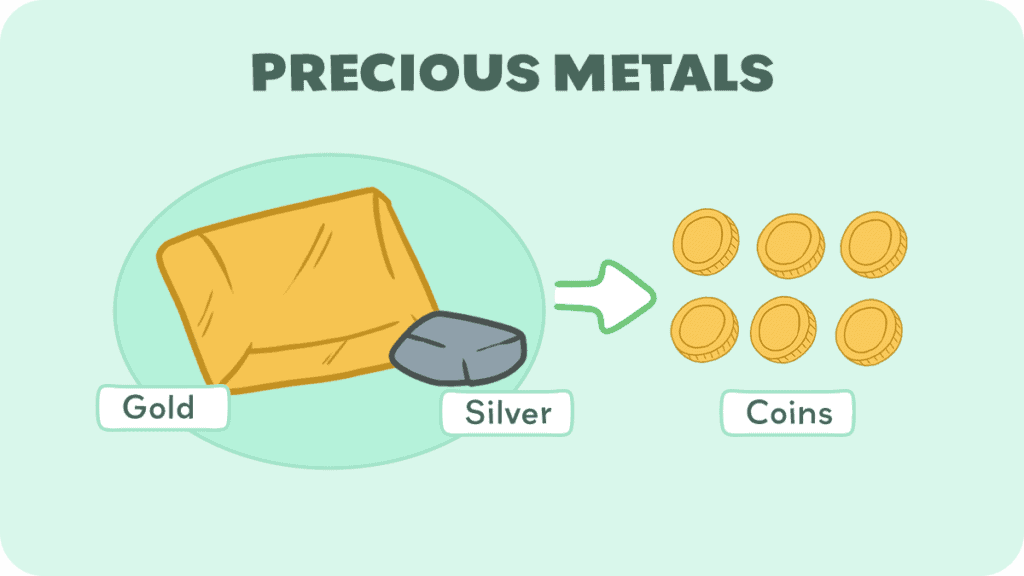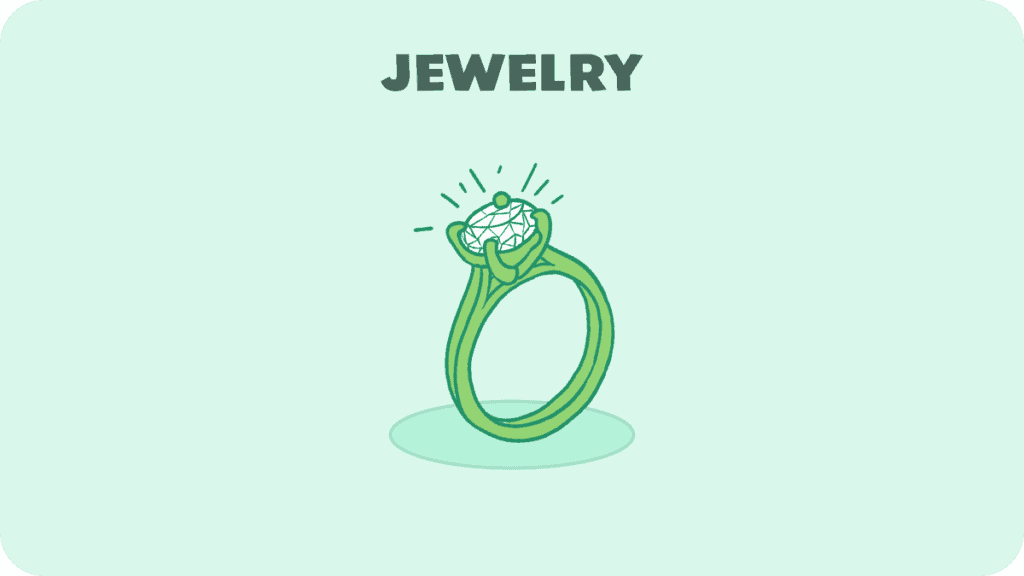You’re familiar with gold, right? You may even be wearing some right now. We use it to make high-end jewelry, including rings, necklaces, and earrings.
The ancient Egyptians used gold to decorate the sarcophagi of their pharaohs, the Indians used it to adorn the Taj Mahal, and Frank Reynolds used it to decorate his chair on Always Sunny (technically, it was gold spray paint, but the idea is the same).
The point is that gold and silver are almost universally admired for their beauty and recognized as a symbol of wealth.
But do you know what, exactly, gold ‘bullion’ is? You may have heard the term—you may even know it’s traded as a commodity, but what is it that differentiates gold ‘bullion’ from other types of gold? How is it different from the gold in your wedding ring?
In this article, we will explore exactly what bullion is and how it is used in the economy.
What is Bullion?

In the financial sector, bullion refers to the content of a precious metal. Basically, bullion is a metal in its purest form. That is, gold bullion is almost pure gold, and silver bullion is almost pure silver.
There are only minor impurities—to account for this, bullion is given a purity rating. For example, gold bullion containing 99.99% pure gold would have a purity rating of .9999.
To qualify as bullion, gold must be officially recognized as 99.5% pure, and silver must be recognized as 99.9% pure. Additionally, bullion is most commonly stored in the form of bars or ingots, though it can take other forms.
How is this different from the gold or silver in your jewelry? Both gold and silver used in jewelry are in alloy form, meaning that the precious metal is combined with some other element.
Let’s start with the gold. The gold in jewelry is typically 10, 14, or 18-karat gold. What this means is that out of 24 parts, 10, 14, or 18 parts will be gold, and the remainder will be alloy.
For example, 10-karat gold is 10 parts gold/14 parts alloy, 14-karat gold is 14 parts gold/10 parts alloy, and 18-karat gold is 18 parts gold/6 parts alloy (24-karat gold is essentially the same as bullion, but rarely used in jewelry due to its softness and lack of durability).
The exact type of alloy used depends on the color of the gold, with white gold, rose gold, and yellow gold all using different alloys.
Now, on to silver. If you happen to be wearing a silver ring, you can likely find a stamp on the inside that says “925”. What this means is that the silver is 92.5% silver and 7.5% alloy. This is the standard in jewelry, as well as high-end silverware.
If you’ve ever heard the phrase “sterling silver” and are wondering how that differs from this 925 silver, the answer is simple. It doesn’t. They are the same thing with the only difference being the name.
How Bullion is Created

The first step to creating gold (or silver) bullion is to find the precious metal itself. Deposits must be discovered before mining operations can begin.
Once discovered, mining companies will extract gold ore—a combination of gold and mineralized rock. Once the ore is obtained, the gold (or silver) itself must be extracted from the ore and purified.
There are several ways of purifying gold to make gold bullion. They include:
- Direct fusion with fluxes (a chemical cleaning, flowing, or purifying agent)
- Roasting, followed by fusion
- Treatment with sulphuric acid, followed by fusion
- Lead fusion with cupellation
- Volitilisation of the zinc
Once purified, the gold or silver bullion can be poured into a mold and stored as bars or ingots.
Who Holds Bullion and Why
Bullion is often held by central banks in reserve. The most famous of these depositories is Fort Knox, which holds about half the stored gold of the US Treasury.
During the gold standard, nations would hold this gold in reserve to back their currency, setting the price of their currency at a certain amount of gold.
For example, before the US abandoned the gold standard in 1971, the price of the US dollar was set to $35 per troy ounce under the Bretton Woods Agreement.
Today, around 20% of the world’s mined gold is held in reserve as bullion by central banks, which use it to settle international debts or stimulate the economy through gold lending.
Institutional investors such as mutual funds, pensions, and insurance companies may also hold gold bullion as a hedge against inflationary effects on their portfolios. Because gold is intrinsically valuable—meaning it has value just by existing—it can be more stable and less prone to inflation than other investment instruments such as stocks and bonds.
Additionally, bullion banks are involved in various activities in the precious metals market, including clearing, risk management, hedging, trading, vaulting, and acting as intermediaries between lenders and borrowers.
These banks are almost all members of the London Bullion Market Association (LBMA). This is an over-the-counter (or OTC) market, which is a dealer network for financial products, commodities, or securities that don’t trade on centralized exchanges.
Examples of LBMA banks include:
- BNP Paribas
- Citibank
- Credit Suisse
- Goldman Sachs
- HSBC
- ICBC Standard Bank
- JP Morgan Chase
- Merrill Lynch
- Morgan Stanley
- TD Bank
- UBS
- Standard Chartered Bank
Bullion as a Hedge Against Inflation

As we discussed, precious metals in the form of bullion are often used to protect against inflation. Demand for these metals is determined in part by demand from jewelry companies and others that use them in their products.
However, it can also be influenced by perceptions of the economy, with demand increasing during times of economic instability as more people seek to transition to precious metals to protect against inflation. Here’s why.
Inflation can erode the returns on investments such as bonds, or even lead to losing money. For example, if you bought a bond at 5% interest, your savings would grow by 5%. However, if inflation is 10%, your spending power would have actually decreased by 5%.
Now consider precious metals. Since they are a commodity, the price of precious metals tends to rise along with other prices in the economy.
Thus, if you’d have bought gold instead, its price would likely have increased 10% along with everything else, thus preserving your spending power. This is why investors favor precious metals such as gold and silver during times of high or unpredictable inflation.
Additionally, precious metals have always been valued, and are likely to have value in the future. Compare that with a stock, which could quickly become worthless.
If you suspect the stock market may struggle, it makes sense to move away from stocks and toward precious metals as a way to protect against potential economic instability.
Ways for Individuals to Invest
Though bullion banks trade on an OTC market that can be inaccessible to average investors, there are several ways that individuals can invest in gold bullion.
Physical Form
The first is the physical form. Gold and silver bars and coins can be purchased from a reputable dealer. These metals can then be stored however one wishes to store their valuables—either at home, in a safety deposit box at a bank, or buried in the backyard.
If you don’t want to have gold bars lying around, you can also buy it in paper form. This works similarly to currencies during the gold standard in that, instead of getting the metal itself, you’ll be purchasing a paper certificate that represents the gold or silver. However, this certificate can be exchanged for the metal or its cash equivalent on demand.
Exchange-traded Funds
Additionally, one can access the gold bullion market indirectly with the purchase of exchange-traded funds (ETFs). These are funds that contain a collection of securities that are put into an account, and shares of the fund are then sold off like stocks. They typically track an underlying index—in this case, the ETF would track the index price of the relevant metal.
This allows individual investors to access the gold and silver markets without having to buy the physical commodity itself. They can typically be purchased through a standard brokerage account such as Vanguard, an IRA, or brokerage account. With low fees and easy transactions, ETFs are a convenient way for ordinary investors to access the gold and silver markets.
Futures Contracts
Finally, investors can buy bullion futures contracts. These are contracts to buy or sell a commodity at a preset price on a given date in the future. The buyer will not own the gold until the contract’s date—however, they can buy or sell the contract itself, the price of which will fluctuate with the market price.
It should be noted that these contracts are expensive, costing as much as $100,000, and therefore might not be suitable for individual investors. Though they can be quite profitable, there is a corresponding risk that can result in equally substantial losses.
Conclusion
Gold, silver, and other precious metals have been valued throughout history, and their value continues to this day. Bullion consists of these metals in their purest form and can be a worthwhile investment, especially for those looking to protect themselves from inflation.
Thank you for reading this article. We hope you’ll join us again as we continue to look at interesting education topics in the world of finance.

